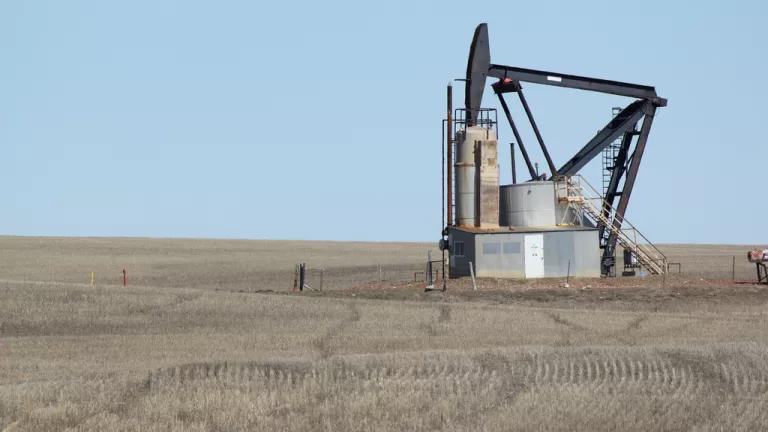
As she followed a zigzag path away from a tall oil pump in western North Dakota, wildlife biologist Sarah Thompson kept her eyes peeled and listened intently. She could hear the warble of chestnut-collared longspurs. A bit farther on, she heard Baird’s sparrows trilling and the ringing calls of Sprague’s pipits. She noted each peep.
For more than three years, Thompson and a handful of other biologists have conducted surveys like this at nearly 70 North Dakota well pads in order to collect data on the impact oil infrastructure might be having on grassland birds. Their findings, published recently in Biological Conservation, show that the farther the researchers got from the wells (they typically walked up to a third of a mile away), the more birds and bird diversity they found. Moreover, they noted that some birds, like Sprague’s pipit, a candidate for listing under the Endangered Species Act, weren’t heard at all within 380 yards of any oil well.
“Oil development is sort of high profile, but I don’t think a lot of people, when they see North Dakota, are like, ‘Oh, that’s a great place to go grassland birding,’” says Thompson. In reality, the state is an important avian breeding ground and has been historically flush with prairie birds.
North Dakota has gone through its fair share of oil booms in recent decades, but none as dramatic as the one currently tapping into Bakken shale. Around 2008, drills began boring into the ground faster than the gopher in Caddyshack, and a web of new and improved roads popped up (in 2013, the state spent $390 million to upgrade 270 miles of asphalt around the city of Williston alone). By one estimate, the Bakken has produced 167 billion barrels of oil to date. Fewer pumps have appeared since oil prices dropped last year, but still, 10,000 more wells exist now than a decade ago.

Once an oil company fracks the shale, it installs one or more bobbing pump jacks to pull oil up from the reserves below. To birds, these tall structures resemble trees, which grassland birds don’t like, as they provide perches for raptors and hiding spots for other predators like raccoons and skunks. Researchers had a hunch the region’s birds might avoid the pump jacks and the busy network of roads that lead to them; that’s why they headed into the field to take a look.
Although North Dakota doesn’t have a wide variety of native species, the 17 types of birds that do live there are highly adapted to the landscape and its knee-high grasses. But over the years, these birds have had to cope with several newcomers to the plains in addition to oil pump jacks. Wind turbines and corn and soybean fields are now encroaching on more and more of the birds’ land.
Some lucky species appear to be adapting. The brown-headed cowbird, for instance, doesn’t seem frightened off by pump jacks at all. And research shows that well pads may be a boon for sharp-tailed grouse, which build nests in the ground near drill pads. Grouse chicks have higher survival rates, as predators tend to steer clear of such human-prone areas.
But for species like the Baird’s sparrow and the Sprague’s pipit, the combination of stressors (less land and more human activity, noise, and soaring structures) is alarming. According to Breeding Bird Survey and Christmas Bird Count data, Sprague’s pipit numbers have declined by more than 80 percent in the past four decades. The Baird’s sparrow hasn’t done much better; its population has fallen by 79 percent over the same period. With each new well drilled, the birds’ chances seem dimmer.
Energy companies aren’t entirely oblivious to the prairie birds’ plight and are making some attempts to keep their footprints small. These efforts include putting no more than one well pad every two square miles, leaving the rest of the land open for wildlife, and positioning well pads near existing roads, says Tessa Sandstrom, a communications specialist with the North Dakota Petroleum Council, a group that represents 550 oil and gas companies.
But the study’s authors say that more should be done. For instance, clustering drill pads would concentrate human activity and leave even more avian habitat undisturbed. And by comparing breeding ranges with the oil industry’s expansion plans, more-informed decisions could be made to keep our prairies humming with chirps, peeps, squeaks, and trills into the future.
This article was originally published on onEarth, which is no longer in publication. onEarth was founded in 1979 as the Amicus Journal, an independent magazine of thought and opinion on the environment. All opinions expressed are those of the authors and do not necessarily reflect the policies or positions of NRDC. This article is available for online republication by news media outlets or nonprofits under these conditions: The writer(s) must be credited with a byline; you must note prominently that the article was originally published by NRDC.org and link to the original; the article cannot be edited (beyond simple things such grammar); you can’t resell the article in any form or grant republishing rights to other outlets; you can’t republish our material wholesale or automatically—you need to select articles individually; you can’t republish the photos or graphics on our site without specific permission; you should drop us a note to let us know when you’ve used one of our articles.

What Is the Keystone XL Pipeline?
The Long, Long Battle for the Arctic National Wildlife Refuge
When You Poison Our Lands, You Poison Us